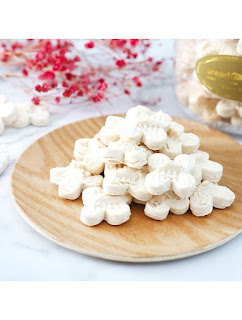History Of Kueh Bangkit
Singaporeans enjoy eating kueh bangkit biscuits as Chinese New Year treats during the annual Lunar Chinese New Year festival. They enjoy them because they are easy to chew and melt in their mouths like ice cream. Furthermore, the bites emit a delicious coconut and pandan fragrance. However, kueh bangkit has a history that can be traced back through generations of Chinese in Singapore, as well as a reputation as a popular CNY treat.
Information on Chinese New Year - https://www.newworldencyclopedia.org/entry/Chinese_New_Year
Kueh bangkit's origins can be traced back to the Peranakan and Malay communities of old Malaya. Kueh bangkit is a traditional Malay cookie that is popular during Hari Raya among the Southeast Asian community, with the majority of it being consumed in Singapore, Malaysia, and Indonesia. The name "kueh bangkit" comes from the fact that the cookies rise during baking. In reality, the Malay word 'bangkit' means 'rising.'
Some, however, claim that this CNY treat originates in China, where they would be used as religious sacrifices to ancestors at altars. Traditionally, the kueh bangkit biscuits are prepared in the shape of money. Chrysanthemum and goldfish are popular shapes for kueh bangkit. In household beliefs, both have some associated wealth implications. Traditional Chinese superstitious people also believe that eating these cookies will help them overcome whatever challenges they face in the next year. Sesame seeds were occasionally put on kueh bangkit cookies to symbolise fertility in their homes.
Tapioca flour and coconut milk are frequent ingredients and recipes used in the baking process. The latter would lead you to believe it is Peranakan in origin, as it is more of a Nyonya cuisine item. The most prevalent kueh bangkit colour is white, which is made from tapioca. In Singapore, the white kueh bangkit is the most popular. Gula melaka is another recipe utilised in the Singapore community to make the kueh bangkit sweeter.
Women would bake these cookies in the days before up to the actual holiday, in this festive period, to prepare for visiting family and friends. Some women treat them like tiny companies, selling the kueh bangkit to others who are too busy to bake or shop for them.
Among the CNY cookies, kueh bangkit is a popular choice. People would eat them or simply place them in their mouths to melt naturally, as if they were chocolate bars. Consider these kueh bangkit to be delicate and soluble tapioca flour-based coconut cream biscuits. Even small children enjoy treating them as if they were candy bars. It would also be beneficial for the elderly who have lost their teeth to eat them during this special time of year.



Comments
Post a Comment